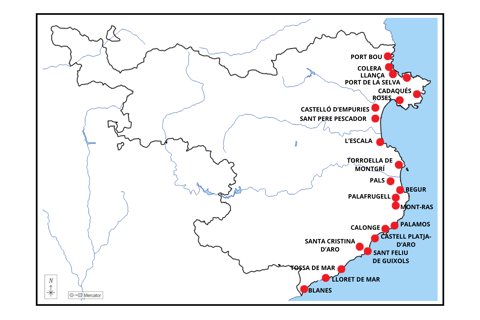Costa Brava
The Costa Brava is one of the most emblematic coastal areas of Catalonia, located in the province of Girona, in northeastern Spain, along the Mediterranean Sea. It stretches from Blanes in the south to Portbou on the French border, covering approximately 200 km of coastline.
Origin of the name ‘Costa Brava
The term ‘Costa Brava’ was coined by the Catalan journalist Ferrán Agulló in an article published in the newspaper ‘La Veu de Catalunya’ on 12 September 1908. The name evokes the wild and rugged nature of the coast, characterised by its cliffs, steep rocks and hidden coves. In Catalan, ‘brava’ means wild or abrupt, describing the geological formations that contrast with the smoother, wider beaches of other areas of the Spanish Mediterranean.
Initial delimitation
The Costa Brava in its initial delimitation covered exclusively the coastal municipalities of the province of Girona, including towns such as:
Lloret de Mar: Famous for its lively nightlife and beaches
Tossa de Mar: With its spectacular walled old town.
Sant Feliu de Guíxols: Municipality with a natural harbour.
Palamós: Known for its coves and fishing port.
Calella de Palafrugell: A charming village that still conserves its fishing atmosphere.
L'Escala: With the nearby ruins of Empúries.
Cadaqués: Famous for having been a refuge for artists such as Salvador Dalí.
These coastal towns formed the heart of the Costa Brava from Blanes (south) to Portbou (north) in 1908
Origin of the name and evolution.
The name Palafrugell derives from the Latin Palatio Frugelli, meaning ‘rural palace’ or ‘country building’. Throughout the Middle Ages, the area was marked by the construction of defence towers to protect its coasts from pirates (there are still some in Calella, see photo) and agriculture.
In later centuries, it developed as an important industrial centre, particularly related to cork, a key industry in the area that is still remembered in the Cork Museum (articulo) in Palafrugell
Beaches and Coves of Palafrugell
The municipality of Palafrugell boasts some of the most spectacular and sought-after coastal spots on the Costa Brava. Here are the main beaches and coves you can visit in the area:
1. Calella de Palafrugell (attach photo)
Perhaps the most famous of Palafrugell’s coastal villages, Calella de Palafrugell is a former fishing town that has managed to preserve its charm with white houses, blue shutters, and narrow streets leading to small coves with crystal-clear waters.
Some of the standout beaches include Port Bo, Platja d’en Calau, and Platja del Canadell, which are accessible via the Camí de Ronda (coastal path). This scenic trail also provides access to secluded, peaceful coves through some steep and rugged paths. (attach a map image of the coastal path) and include photos of a stunning, significantly empty cove.
Its architectural beauty and rocky coves make it an iconic spot to enjoy breathtaking views. Additionally, it’s renowned for hosting the famous Cantada de Habaneras, a traditional music festival held annually on the first Saturday of July.
2. Llafranc
A charming coastal village with a fine sandy beach and calm waters, Llafranc is a more exclusive and elegant destination, frequented by both tourists and locals seeking tranquility and beauty. This small village has a lovely promenade that stretches along the entire beach, ending at a small marina. Along the promenade, you’ll find a number of high-quality bars and restaurants, where excellent service and fresh seafood are the highlights. There is also a good selection of premium ice cream shops.
Llafranc is home to the Sant Sebastià Lighthouse, offering breathtaking panoramic views of the Costa Brava, especially the village itself. You can also visit the Hermitage of Sant Sebastià de la Guarda and a larger complex of buildings that share the same name (article on Sant Sebastià de la Guarda??).
3. Tamariu
Tamariu is one of the most peaceful and intimate spots in Palafrugell. It maintains a family-friendly and serene atmosphere, with its beach surrounded by pine trees and turquoise waters. The main beach has coarse sand and is lined with a small promenade, where you’ll find bars, restaurants, and local shops selling snorkel gear, swimsuits, and other summer essentials.
Additionally, nearby coves like Aiguaxelida are hidden gems nestled among the rocks. To fully enjoy this charming village, you can rent a kayak and paddle along the coast to the next village of Bergur or drive just five minutes to La Cova d’en Gispert lookout point, where you can witness a truly unique and incomparable sunset over the Costa Brava.
(insertar fotos de los items en negrita y un mapa con el recorrido.)
(Ademas de esto, creacion de articulos de la costa brava de Begur y pals ??)
(articulos de actividades o eventos que se puedan realizar en estas zonas)


